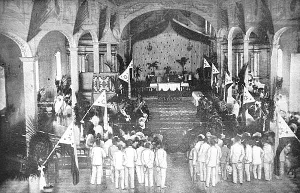On This Day - June 2,1899
- The Siege of Baler ended after 11 months, with 35 surviving Spanish
soldiers surrendered including their commander, Lt. Saturnino Martín Cerezo.
The Filipino revolutionaries laid siege to a fortified church of San Luis
Obispo de Tolosa that defended by Spanish troops in the town of Baler, Aurora,
for 337 days, from 1 July 1898 until 2 June 1899.
Baler was garrisoned by a 50-man detachment of the Second
Expeditionary Battalion Cazadores (“Hunters”) under Capt. Enrique de las
Morenas, as the district political-military governor. On June 1, 1898, Morenas
began to stock food supplies and ammunition, and to fortify the church compound
of San Luis de Tolosa in Baler’s town square against a possible attack.
Then on the night of June 30, 1898, 800 Filipino troops
under Teodorico Luna attacked, and the garrison fell back to the church. The
Spanish had to endure confinement in a small, hot, humid space. As the siege
progressed, their food supply began to diminish through usage and spoilage. On
November 22, 1898, Capt. Morenas succumbed to disease and died, the command
fell to Lt. Saturnino Martin Cerezo. The Filipinos attempted to smoke them out
by setting fires beside the church wall, but were repulsed.
By November 22, 1898, a total of 145 days had elapsed since
the siege began, during which 14 Spanish soldiers died of disease. The
Filipinos also had suffered casualties, mostly from rifle fire the Spanish were
able to inflict on them from their protected firing positions.
By January 1899, Spanish emissaries were brought to Baler,
but again Martin Cerezo turned them away. By April 1899, the Spaniards were run
out of food; they resorted to eating stray dogs, cats, reptiles, snails and
crows. By May 1899, there was yet another attempt to get Lt. Martín Cerezo to
surrender, this time, it was a fellow Spanish officer named Lt. Col. Cristobal
Aguilar y Castañeda, but Cerezo turned it away. However, Lt. Col. Cristobal
Aguilar had brought recent Spanish newspapers, which Cerezo initially
dismissed. Until Cerezo read an article concerning a close friend’s posting.
Convinced that the newspapers were genuine and that indeed Spain had lost the
war, Lt. Martin Cerezo and his men surrendered to the Filipinos on June 2,
1899. Three months later, the survivors, including Martin Cerezo, arrived in
Barcelona where they were received and honored as heroes.
Sources and References:
1. Westfall, M. (2012). The Devil’s Causeway: the true story
of America's first prisoners of war in the Philippines. Guildford: Lyons Press
2. Martin Cerezo, S. (1909). Under the Red and Gold: being
notes and recollections of the siege of Baler. Kansas City: Franklin Hudson
3. Reyes Roces, A., ed. (1978). “The period of armed
struggle, 1896–1900.” Filipino heritage. Vol. 8. Manila: Lahing Pilipino
4. Wikimedia Commons



